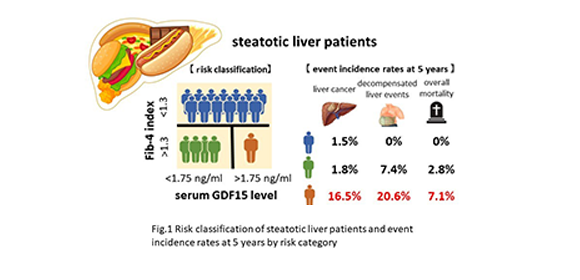
High levels of novel biomarker GDF15 in steatotic liver patients linked to increased liver cancer risk
Researchers at Osaka University have found that patients with steatotic liver disease who have high levels of growth differentiation factor 15 (GDF15) in their blood are more likely to develop liver cancer. By combining blood GDF15 levels with liver stiffness indicators, it is possible to more effectively identify patients at high risk of developing liver cancer, experiencing liver deterioration, and having poor outcomes.
Steatotic (fatty) liver disease is on the rise in many countries around the world. A rise in steatotic liver disease comes with an increase in the number of liver cancer cases associated with the condition. Liver cancer occurs frequently when the liver becomes hard and progresses to cirrhosis. However, liver cancer also occurs at a certain rate even when the liver is only slightly hardened. This is because the number of patients with mildly hardened steatotic liver is very high, which highlights the need for better predictive markers.
In this study, the research team focused on GDF15 levels in the blood and found that patients with steatotic liver disease are more likely to develop liver cancer if their blood GDF15 level is high. In addition, patients with high blood GDF15 levels are more likely to develop liver failure, ascites, hepatic encephalopathy, and other liver cirrhosis-related complicating diseases, leading to increased hospitalization rates. The prognosis for these patients was also found to be poor.
Patients with low-risk liver stiffness (Fibrosis (FIB)-4 index < 1.3) rarely developed liver cancer; thus, the research team developed a new method to more efficiently detect liver cancer by combining blood GDF15 levels and a FIB-4 index > 1.3 (indicating intermediate and high risk for liver stiffness). This approach allows for more efficient identification of patients at high risk of developing liver cancer, those with deteriorating liver conditions, and those with a poor prognosis.
From these results, the use of GDF15 values in steatotic liver patients for clinical applications, such as adjusting the frequency of follow-ups and liver cancer screenings, may lead to the establishment of an efficient screening system for the early detection of liver cancer.
“Liver cancer in the context of steatotic liver is often found at an advanced stage,” says senior author Hayato Hikita. “By identifying patients who are prone to develop liver cancer from steatotic liver and conducting periodic examinations, detection and treatment of liver cancer may be possible in its early stages. Early detection and treatment of liver cancer are also expected to lead to improved prognosis.”
Fig. 1
Risk classification of steatotic liver patients and event incidence rates at 5 years by risk category
Credit: Osaka University
Fig. 2
Incidence rates of liver cancer occurrence, decompensated liver events, and overall mortality in 518 patients with steatotic livers who underwent liver biopsy.
Credit: Osaka University
Fig. 3
Incidence rates of liver cancer occurrence, decompensated liver events, and overall mortality in 216 patients with steatotic livers at a different institution.
Credit: Osaka University
The article, “Serum growth differentiation factor 15 is a novel biomarker with high predictive capability for liver cancer occurrence in patients with MASLD regardless of liver fibrosis,” was published in Alimentary Pharmacology & Therapeutics at DOI: http://doi.org/10.1111/apt.18063.
Related Links
Professor TAKEHARA Tetsuo (Researcher Directory)
EurekAlert!
Asia Research News
